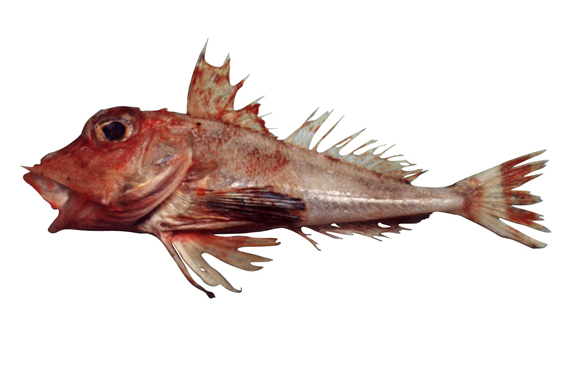Spot-wing Gurnard, Lepidotrigla spiloptera Gunther 1880

A Finspot Gurnard, Lepidotrigla punctipectoralis. Source: Australian National Fish Collection, CSIRO. License: CC by Attribution-Noncommercial
A reddish gurnard with a dark greenish-brown surface and a broad red margin on the inner surface of the pectoral fin and prominent white spots scattered over the non-red areas on the pectoral fin, and a large black patch covering the ventral third to half of fin. The caudal fin has a broad ventrally tapering pink margin and transverse red a broad red band just behind the middle of the fin.
Spot-wing Gurnard, Lepidotrigla spiloptera Gunther 1880
More Info
|
Distribution |
Northwest Shelf, Western Australia, to the Arafura Sea, Northern Territory. Elsewhere the species is widespread in the Indo-West Pacific. Inhabits soft sediment areas often near corals, in coastal and offshore waters. |
|
Features |
Dorsal fin IX, 15-16; Anal fin 14-16; Pectoral fin 11 + 3; Lateral line scales 58-61; Vertebrae 11-12 + 21-22 = 32-33; Gill rakers 0-1 + 6-7 (plus 0-3 rudiments). Body with slight convex curve from posterior part of first dorsal fin base to moderately narrow caudal peduncle; narrow but distinct postorbital notch above and behind each eye and faint furrow across nape at rear of interorbital space; rostral process with broad to deep medial notch and nearly straight to slightly curved anterior edge on each rostral lobe to triangular spine of moderate size at apical corner. Pectoral fins reaching about fourth or fifth anal fin ray, first free pectoral fin ray reaching to between anus and base of third anal fin ray, not or just reaching tip of pelvic fin. |
|
Size |
154 mm SL |
|
Colour |
Body above lateral midline and head reddish, lower half of sides and underside of head white; first dorsal fin pink with elongate red spot on the basal half of fin between third and sixth spines; distal portion of second dorsal reddish, white basally; anal fin white; broad red band just distal to middle of caudal fin with broad ventrally tapering pink margin and transverse red band basally; pelvic fins white; inner surface of pectoral fin dark greenish brown with large black patch covering ventral third to half of fin from base to distal margin except for fine red margin dorsally and distally and broad red margin ventrally, prominent white spots scattered over all but red areas on fin, rays on outer surface white with membranes matching inner surface on upper two thirds of fin, pink ventrally and on free rays. |
|
Fisheries |
An occasional bycatch species in trawl fisheries. |
|
Remarks |
|
|
Similar Species |
This species has previously been mistaken for Lepidotrigla punctipectoralis in northern Australia and south east Asia. |
|
Etymology |
The specific name spiloptera is from the Greek spilotos (= spotted) and pteron (= wing) in reference to the distinctive white spots spread across the inner surface of the wing-like pectoral fin. |
|
Species Citation |
Lepidotrigla spiloptera Gunther 1880, Report on the scientific results of the voyage of H. M. S. Challenger during the years 1873-76. Zoology 1 (pt 6): 1-82, Pls. 1-32. Type locality: Kai Islands, Challenger station 192, Indonesia, Banda Sea, depth 129 fathoms. |
|
Author |
Bray, D.J. & Nguyen, L. 2023 |
|
Resources |
Spot-wing Gurnard, Lepidotrigla spiloptera Gunther 1880
References
Gloerfelt-Tarp, T. & Kailola, P.J. 1984. Trawled Fishes of Southern Indonesia and Northwest Australia. Jakarta : Dir. Gen. Fish. (Indonesia), German Tech. Coop., Aust. Dev. Ass. Bur. 406 pp.
Gomon, M.F. & Kawai, T. 2018. A review of Indonesia’s Indian Ocean species of Lepidotrigla gurnards (Teleostei: Scorpaeniformes: Triglidae) with descriptions of three new species from southern coastal waters. Raffles Bulletin of Zoology 66: 624-651.
Günther, A. 1880. Report on the shore fishes procured during the voyage of H.M.S Challenger, in the years 1872–1876. Report on the Scientific Results of the Voyage of H.M.S. Challenger 1873–1876, Zoology 1(6): 1-82 pls 1-32
Larson, H.K., Williams, R.S. & Hammer, M.P. 2013. An annotated checklist of the fishes of the Northern Territory, Australia. Zootaxa 3696(1): 1-293
Motomura, H., Matsuura, K. & Khan, M. 2018. Lepidotrigla spiloptera. The IUCN Red List of Threatened Species 2018: e.T114192542A114749239. https://dx.doi.org/10.2305/IUCN.UK.2018-2.RLTS.T114192542A114749239.en. Downloaded on 01 December 2021.
Richards, W.J. 1992. Comments on the genus Lepidotrigla (Pisces: Triglidae) with descriptions of two new species from the Indian and Pacific oceans. Bulletin of Marine Science 51(1): 45-65.
Richards, W.J. 1999. Family Triglidae. pp. 2359-2382 in Carpenter, K.E. & Niem, T.H. (eds). The Living Marine Resources of the Western Central Pacific. FAO Species Identification Guide for Fisheries Purposes. Rome : FAO Vol. 4 pp. 2069-2790.
Richards, W.J. & Saksena, V.P. 1977. Systematics of the gurnards, genus Lepidotrigla (Pisces, Triglidae), from the Indian Ocean. Bulletin of Marine Science 27(2): 208-222 figs 1-6
Sainsbury, K.J., Kailola, P.J. & Leyland, G.G. 1984. Continental Shelf Fishes of Northern and North-Western Australia. Canberra : Fisheries Information Service 375 pp. figs & pls.

